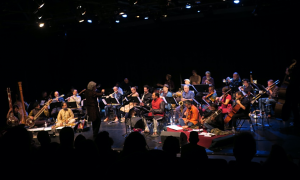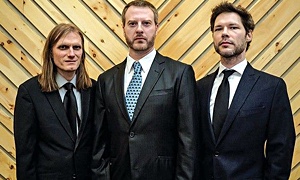Home » Jazz Articles » Live From Philadelphia » Hip Hop Slop?
Hip Hop Slop?
Jazz was a race blender long before Rap reared it
He plays down the fact that much rap, the music of hip-hop culture, use rhyming repetition of such eloquent curse words as “ F....” this and F: that if you don’t know where it’s at. He also argues that this music, apparently an outgrowth of Black kids doing their own thing in the Bronx (not my favorite New York borough) produced very listenable recordings.
I was standing on the street corner of 33rd & Walnut Street not long ago when a car came by with the loud speaker blasted out some rap and ruin music with the “singer” shouting out how “you mother-F....” this and that several times in succession. Granted, I come from another generation where the continued references to sex or bodily functions was not considered polite, much less funny.
DeLuca went on the claim how this largely Black youth culture music was being picked up by young White kids and helping to bring the two groups together, inferentially as if there were something new. He apparently does not know or care to acknowledge the power of jazz to do the same thing far earlier and more effectively.
Jazz, considered by many (particularly in Europe) as America’s most significant indigenous cultural creation, was, of course, largely a product of the African American community. Louis Armstrong, Bunk Johnson and King Oliver were soon followed, however, by such as Bix Beiderbecke, George Brunies and Wild Bill Davison. Jazz was a race blender long before Rap reared it’s head.
While various RAP stars are facing jail time for acting out their stupid simplistic songs about doing drugs and killing one another I had the great pleasure of hearing two different more harmonious music concerts by Black artists. One was The Blind Boys of Alabama rendering stirring soul music at the Kimmel Center and the other was the play, “It Aint’ Nothin’ But The Blues” with various Black singers bringing the audience to their feet in applause at the Prince Theater.
The audience for both shows was largely White but with many African Americans participating. In my youth, most of the audience at the Apollo in Harlem was African American but with a substantial number of White people in attendance. Your color did not make any difference. It was the music that mattered.
I had the great pleasure of going out to the old Blue Note Monday night jam sessions on Limekiln Pike where Tony Williams held forth with his group allowing other musicians to sit in for the second set. The audience was largely African American, but many White people played and cheered. We came together with music that had rhythm.
As someone reared in New York city during the great Swing Street years, I was surprised and delighted at how much good jazz there was in Philadelphia. You would not realize how much if you depended upon the Inquirer for jazz coverage.
This town has a an all-time, all-star aggregation of great jazz people:Tenor sax men—Larry McKenna, Bootsie Barnes and Jimmy Oliver. Guitarists—Jimmy Bruno, Jimi Odell and Pat Martino. Trumpeters like John Swana and piano men like Eddie Green and Sid Simmons and the list goes on longer than this paper has room for.
If Mr. DeLuca and some of his hip-hop rappers want to hear some real music there is an all-star jazz presentation at the Kimmel Center tonight. It is the 50th anniversary touring production of George Wein’s now-famous Newport Jazz Festival. It features Randy Brecker, trumpet; James Moody and James Carter, saxophones; Cedar Wilson, piano; Howard Alden, guitar; Lewis Nash, drums and Peter Washington, bass.
Or if he cannot quite make that trip he can simply stop by such diverse jazz spots as Chris’ Jazz Cafe, Ortlieb’s Jazz Haus, Zanzibar Blue, Sedgwick Cultural Center, and even the Philadelphia Museum of Art.
To be fair to the Inquirer, it should be noted that this same issue carried a big story by Tom Moon, the paper’s music critic, on a Bucks County jazz recording studio. Mr. DeLuca, is the Inquirer’s “popular” music critic and I concede that jazz, like classical music, is not too popular these days. With a few more pieces by Mr. DeLuca and it may well never be.
< Previous
Diana Krall
Next >
February 2004
Comments
Tags
For the Love of Jazz
 All About Jazz has been a pillar of jazz since 1995, championing it as an art form and, more importantly, supporting the musicians who create it. Our enduring commitment has made "AAJ" one of the most culturally important websites of its kind, read by hundreds of thousands of fans, musicians and industry figures every month.
All About Jazz has been a pillar of jazz since 1995, championing it as an art form and, more importantly, supporting the musicians who create it. Our enduring commitment has made "AAJ" one of the most culturally important websites of its kind, read by hundreds of thousands of fans, musicians and industry figures every month.





















